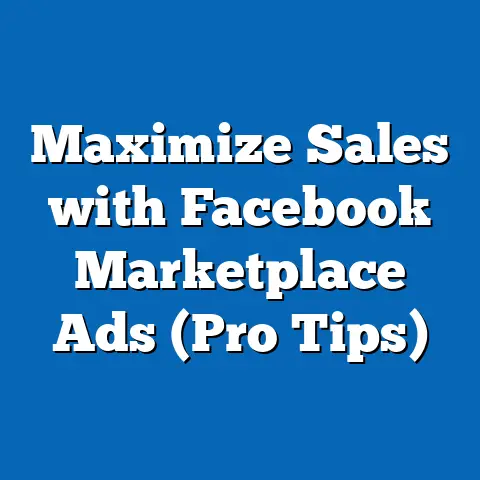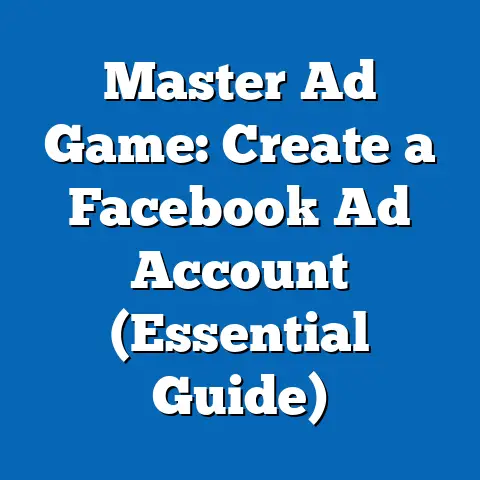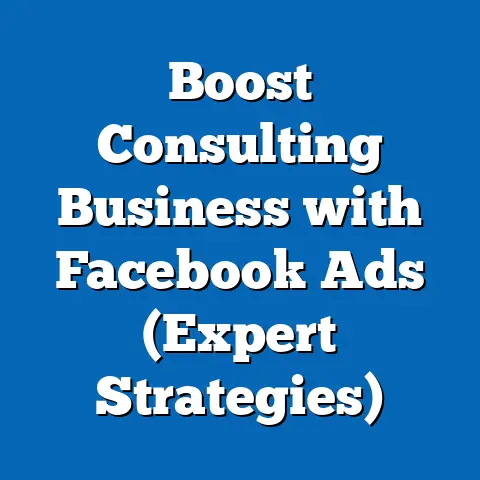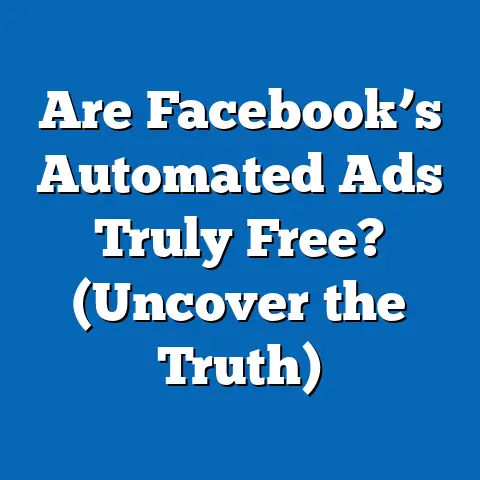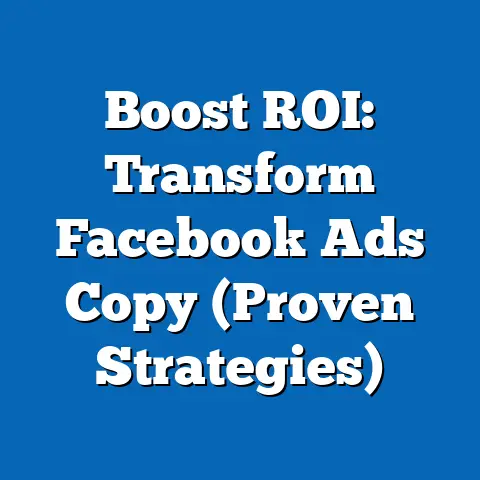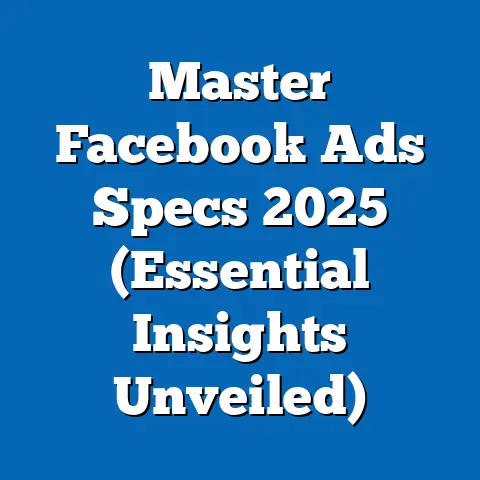Master Facebook Ads: Essential Dos & Don’ts (Expert Insights)
The digital marketing landscape is a constantly shifting terrain, and if there’s one platform that continues to dominate the social advertising scene, it’s Facebook. As of 2024, Facebook boasts over 3 billion monthly active users, making it a goldmine for businesses looking to reach a vast and diverse audience. Global ad spending on Facebook is projected to reach staggering heights, with small businesses increasingly relying on the platform for targeted marketing campaigns.
I’ve spent years navigating the ins and outs of Facebook Ads, witnessing firsthand the incredible potential it holds for businesses of all sizes. But let me tell you, it’s not as simple as throwing money at the platform and expecting magic to happen. The difference between a wildly successful campaign and a complete flop often comes down to understanding the essential dos and don’ts.
In this article, I’m going to share my expert insights, drawn from real-world experiences and industry best practices, to help you master Facebook Ads. Whether you’re a seasoned marketer or just starting out, this guide will provide you with the knowledge you need to craft effective campaigns, avoid common pitfalls, and maximize your ROI.
Understanding the Facebook Ads Ecosystem
Before diving into the dos and don’ts, let’s take a moment to understand the Facebook Ads ecosystem. It’s a complex machine with many moving parts, but grasping the fundamentals will set you up for success.
At its core, Facebook Ads allows you to target specific audiences with tailored messages. The platform offers a wide range of ad formats, each designed to achieve different objectives. Here’s a quick rundown of some popular options:
- Carousel Ads: Showcase multiple images or videos in a single ad, perfect for highlighting different products or features.
- Video Ads: Capture attention with engaging video content, ideal for storytelling and demonstrating product usage.
- Image Ads: Simple yet effective, image ads can be used to drive traffic to your website or promote special offers.
- Slideshow Ads: Combine multiple images or videos into a dynamic slideshow, a great way to create visually appealing content on a budget.
- Collection Ads: Designed for e-commerce businesses, collection ads allow users to browse and purchase products directly from the ad.
Beyond ad formats, Facebook’s targeting capabilities are what truly set it apart. You can target users based on a wide array of factors, including:
- Demographics: Age, gender, location, education, and more.
- Interests: Hobbies, passions, and interests based on their Facebook activity.
- Behaviors: Purchase history, device usage, and other online behaviors.
- Connections: People who like your page, friends of people who like your page, or those who have engaged with your content.
- Custom Audiences: Upload your own customer data to target existing customers or create lookalike audiences.
- Lookalike Audiences: Find new customers who share similar characteristics with your existing customers.
The Facebook Ads Manager: Your Command Center
The Facebook Ads Manager is the central hub for creating, managing, and analyzing your campaigns. It’s where you’ll define your target audience, set your budget, design your ads, and track your performance. It’s also tightly integrated with other Meta platforms like Instagram and Messenger, allowing you to run ads across multiple channels from a single interface.
Navigating the Ads Manager can be a bit daunting at first, but I promise it gets easier with practice. Familiarize yourself with the different sections, including:
- Campaigns: Where you set your overall advertising objective and budget.
- Ad Sets: Where you define your target audience, placement, and schedule.
- Ads: Where you create the actual ad creative, including the copy, images, and call-to-action.
Takeaway: Understanding the Facebook Ads ecosystem, including the various ad formats, targeting options, and the Ads Manager, is crucial for creating effective campaigns.
The Essential Dos of Facebook Ads
Now that we’ve covered the basics, let’s dive into the essential dos of Facebook Ads. These are the best practices that I’ve found to be consistently effective over the years.
1. Do Define Clear Objectives
One of the biggest mistakes I see businesses make is launching Facebook Ads without a clear understanding of what they want to achieve. Are you trying to increase brand awareness, generate leads, drive sales, or something else entirely?
Setting specific, measurable, achievable, relevant, and time-bound (SMART) goals is essential for guiding your ad creation and measuring your success. For example, instead of saying “I want to increase sales,” try “I want to increase online sales by 20% in the next quarter.”
Your objective will influence everything from your ad format to your targeting strategy to your call-to-action. If you’re focused on brand awareness, you might choose video ads and target a broad audience. If you’re focused on lead generation, you might use lead ads and target a more specific audience interested in your product or service.
Example:
- Objective: Increase website traffic by 30% in the next month.
- Strategy: Run image ads with a compelling headline and a clear call-to-action, targeting users interested in your industry.
Takeaway: Always start with a clear, well-defined objective to guide your Facebook Ads strategy.
2. Do Conduct Thorough Audience Research
You could have the most beautifully designed ad in the world, but if you’re showing it to the wrong people, it’s going to fall flat. That’s why thorough audience research is absolutely crucial.
Facebook provides a wealth of data and tools to help you identify your target audience. The Audience Insights tool is a great place to start. It allows you to explore the demographics, interests, and behaviors of people on Facebook, giving you valuable insights into your potential customers.
You can also create custom audiences by uploading your own customer data, such as email addresses or phone numbers. This allows you to target existing customers with special offers or create lookalike audiences. Lookalike audiences are one of the most powerful targeting tools on Facebook. They allow you to find new customers who share similar characteristics with your existing customers, significantly expanding your reach and improving your chances of success.
Example:
- You run an online store selling organic baby food.
- You can create a custom audience of existing customers who have purchased baby food in the past.
- Then, you can create a lookalike audience based on this custom audience to find new customers who are likely to be interested in your products.
Takeaway: Invest time in understanding your target audience using Facebook’s tools and data to create highly targeted campaigns.
3. Do Create Engaging Content
In today’s crowded digital landscape, you have seconds to capture someone’s attention. That’s why creating engaging content is paramount. Your ad copy should be clear, concise, and compelling, highlighting the benefits of your product or service. Your visuals should be eye-catching and relevant to your target audience.
A/B testing is your best friend here. Experiment with different headlines, images, and calls-to-action to see what resonates best with your audience. Don’t be afraid to try new things and push the boundaries of your creativity.
Example:
- You’re running an ad for a new fitness app.
- Instead of simply saying “Download our app,” try a more compelling headline like “Transform Your Body in 30 Days” or “Get Fit and Healthy with Our Personalized Training Plans.”
- Use high-quality images or videos of people using your app and achieving their fitness goals.
Takeaway: Craft compelling ad copy and visuals that resonate with your target audience, and use A/B testing to optimize your content for maximum engagement.
4. Do Monitor and Optimize Campaigns
Launching a Facebook Ad campaign is not a “set it and forget it” process. You need to continuously monitor your performance and make adjustments based on the data you’re seeing.
Track key performance indicators (KPIs) such as:
- Click-Through Rate (CTR): The percentage of people who click on your ad.
- Cost Per Click (CPC): The amount you pay for each click on your ad.
- Conversion Rate: The percentage of people who take the desired action after clicking on your ad (e.g., making a purchase, filling out a form).
- Return on Ad Spend (ROAS): The amount of revenue you generate for every dollar you spend on advertising.
If you’re not seeing the results you want, don’t be afraid to make changes to your targeting, ad creative, or budget. Experiment with different strategies and see what works best for your business.
Example:
- You’re running an ad campaign targeting women aged 25-34 interested in fashion.
- You notice that your CTR is low and your CPC is high.
- You decide to narrow your targeting to women aged 25-34 interested in specific fashion brands.
- You also try a new ad creative with a more compelling headline and a different image.
- After a few days, you see that your CTR has increased and your CPC has decreased.
Takeaway: Continuously monitor your campaign performance and make data-driven adjustments to optimize your results.
5. Do Leverage Retargeting Strategies
Retargeting is one of the most powerful tools in the Facebook Ads arsenal. It allows you to target people who have previously interacted with your business, such as visiting your website, adding items to their cart, or watching your videos.
By showing targeted ads to these users, you can remind them of your product or service and encourage them to take the next step. Retargeting can significantly increase your conversion rates and drive more sales.
Example:
- A user visits your website and adds a pair of shoes to their cart but doesn’t complete the purchase.
- You can create a retargeting ad that shows them the exact pair of shoes they left in their cart, along with a special offer like free shipping or a discount code.
Takeaway: Leverage retargeting to re-engage users who have previously interacted with your business and drive more conversions.
The Essential Don’ts of Facebook Ads
Now that we’ve covered the essential dos, let’s talk about the don’ts. These are the common mistakes that I see businesses make time and time again. Avoiding these pitfalls can save you time, money, and frustration.
1. Don’t Ignore Mobile Optimization
In today’s mobile-first world, ignoring mobile optimization is a recipe for disaster. The vast majority of Facebook users access the platform on their mobile devices, so it’s crucial to ensure that your ads are optimized for mobile viewing.
This means using mobile-friendly ad formats, writing concise ad copy, and using images or videos that look good on smaller screens. Test your ads on different mobile devices to ensure they display correctly and load quickly.
Example:
- Use the carousel ad format to showcase multiple products in a visually appealing way on mobile devices.
- Write short, punchy headlines that grab attention on smaller screens.
- Use high-resolution images that look crisp and clear on mobile devices.
Takeaway: Optimize your Facebook Ads for mobile viewing to reach the majority of users on the platform.
2. Don’t Overlook the Importance of Compliance
Facebook has strict advertising policies that you need to adhere to. Violating these policies can result in ad disapproval, account suspension, or even permanent banishment from the platform.
Make sure you’re familiar with Facebook’s advertising guidelines and that your ads comply with all applicable rules and regulations. Pay particular attention to policies related to:
- Prohibited Content: Ads that promote illegal products or services, discriminate against protected groups, or contain misleading or deceptive information.
- Personal Attributes: Ads that directly or indirectly mention or imply a person’s race, ethnicity, religion, age, sexual orientation, or other personal attributes.
- Health and Medical: Ads that promote health or medical products or services, or that make claims about health outcomes.
Example:
- Avoid running ads that promote weight loss supplements or make unsubstantiated claims about their effectiveness.
- Don’t target ads based on sensitive personal attributes like religion or political affiliation.
Takeaway: Familiarize yourself with Facebook’s advertising policies and ensure your ads comply with all applicable rules and regulations to avoid penalties.
3. Don’t Neglect Ad Frequency
Showing the same ad to the same person over and over again can lead to ad fatigue. This happens when users become tired of seeing your ads and start to ignore them, or even worse, develop a negative association with your brand.
To avoid ad fatigue, it’s important to manage your ad frequency. This refers to the number of times a user sees your ad over a given period of time. You can control ad frequency in the Facebook Ads Manager by setting frequency caps.
Example:
- Set a frequency cap of 3 impressions per week to ensure that users don’t see your ad more than three times in a week.
- Rotate your ad creative regularly to keep your content fresh and engaging.
- Segment your audience and show different ads to different groups of users.
Takeaway: Manage your ad frequency to avoid ad fatigue and keep your audience engaged without overwhelming them.
4. Don’t Rely Solely on One Ad Format
Sticking to the same ad format can become monotonous and lead to decreased engagement. Diversifying your ad formats keeps your content fresh and appealing to different audience segments.
Experiment with different ad formats like:
- Image Ads: Simple and effective for driving traffic to your website.
- Video Ads: Engaging and attention-grabbing for storytelling and product demonstrations.
- Carousel Ads: Showcase multiple products or features in a single ad.
- Slideshow Ads: Create visually appealing content on a budget.
- Collection Ads: Designed for e-commerce businesses to showcase products and drive sales.
Example:
- If you’ve been running image ads for a while, try switching to video ads to see if you can capture more attention.
- Use carousel ads to showcase different features of your product or service.
- Experiment with slideshow ads to create visually appealing content on a budget.
Takeaway: Diversify your ad formats to keep your content fresh and appealing to different audience segments.
5. Don’t Forget to Test and Learn
The world of Facebook Ads is constantly evolving, so it’s essential to continuously test and learn. Don’t be afraid to experiment with different strategies, ad types, and creative elements to find what resonates best with your audience.
A/B testing is your best friend here. Test different headlines, images, calls-to-action, and targeting options to see what works best. Use the data you collect to optimize your campaigns and improve your results.
Example:
- Test different headlines to see which one generates the most clicks.
- Experiment with different images to see which one captures the most attention.
- Try different calls-to-action to see which one drives the most conversions.
- Test different targeting options to see which audience segment is most responsive.
Takeaway: Embrace a culture of continuous experimentation and use A/B testing to optimize your campaigns and improve your results.
Expert Insights
To further illustrate the dos and don’ts of Facebook Ads, I’ve gathered some expert insights and real-world examples.
Expert Quote:
“Facebook advertising is not a one-size-fits-all solution. It requires a deep understanding of your target audience, a willingness to experiment, and a commitment to continuous optimization.” – Neil Patel, Digital Marketing Expert
Case Study: Successful Facebook Ad Campaign
- Company: A local coffee shop looking to increase brand awareness and drive foot traffic.
- Strategy:
- Defined a clear objective: Increase foot traffic by 15% in the next month.
- Conducted thorough audience research: Targeted users aged 25-44 living within a 5-mile radius of the coffee shop, interested in coffee, local events, and breakfast.
- Created engaging content: Used high-quality images of their coffee and pastries, along with compelling ad copy highlighting their unique offerings and inviting users to visit.
- Monitored and optimized campaigns: Tracked foot traffic and adjusted their targeting and ad creative based on the data they were seeing.
- Leveraged retargeting strategies: Showed ads to users who had previously visited their website or interacted with their Facebook page.
- Results: Increased foot traffic by 20% in the next month, exceeding their initial objective.
- Defined a clear objective: Increase foot traffic by 15% in the next month.
- Conducted thorough audience research: Targeted users aged 25-44 living within a 5-mile radius of the coffee shop, interested in coffee, local events, and breakfast.
- Created engaging content: Used high-quality images of their coffee and pastries, along with compelling ad copy highlighting their unique offerings and inviting users to visit.
- Monitored and optimized campaigns: Tracked foot traffic and adjusted their targeting and ad creative based on the data they were seeing.
- Leveraged retargeting strategies: Showed ads to users who had previously visited their website or interacted with their Facebook page.
Case Study: Unsuccessful Facebook Ad Campaign
- Company: An e-commerce business selling clothing.
- Strategy:
- Launched a broad ad campaign targeting all Facebook users interested in clothing.
- Used generic ad copy and low-quality images.
- Failed to monitor and optimize their campaigns.
- Results: Low click-through rates, high cost per click, and no increase in sales.
- Launched a broad ad campaign targeting all Facebook users interested in clothing.
- Used generic ad copy and low-quality images.
- Failed to monitor and optimize their campaigns.
Emerging Trends:
- AI-Powered Advertising: Facebook is increasingly using AI to automate and optimize ad targeting and creative processes.
- Personalized Advertising: Consumers are demanding more personalized advertising experiences.
- Privacy-Focused Advertising: Facebook is adapting to new privacy regulations and consumer expectations by offering more privacy-focused advertising options.
Takeaway: Learn from successful and unsuccessful campaigns, stay informed about emerging trends, and adapt your strategies accordingly.
Conclusion
Mastering Facebook Ads requires a combination of knowledge, skill, and continuous learning. By understanding the essential dos and don’ts, you can craft effective campaigns, avoid common pitfalls, and maximize your ROI.
Remember to:
- Define clear objectives.
- Conduct thorough audience research.
- Create engaging content.
- Monitor and optimize campaigns.
- Leverage retargeting strategies.
- Optimize for mobile.
- Comply with Facebook’s advertising policies.
- Manage ad frequency.
- Diversify your ad formats.
- Test and learn continuously.
The world of Facebook Ads is constantly evolving, so it’s crucial to stay informed about industry trends and continuously refine your strategies. By following these guidelines, you can unlock the full potential of Facebook Ads and achieve your advertising goals.
So, what are you waiting for? It’s time to put these insights into action and start creating Facebook Ad campaigns that drive real results for your business. Good luck!

